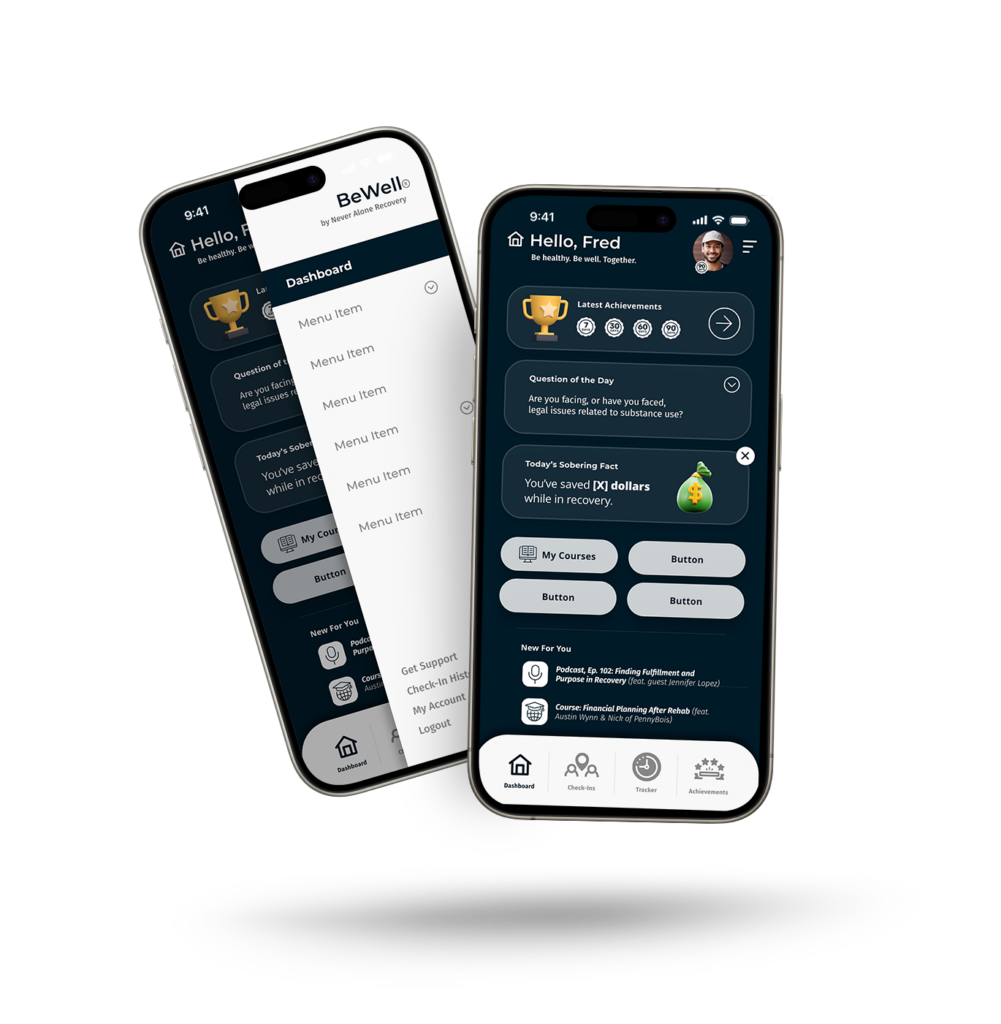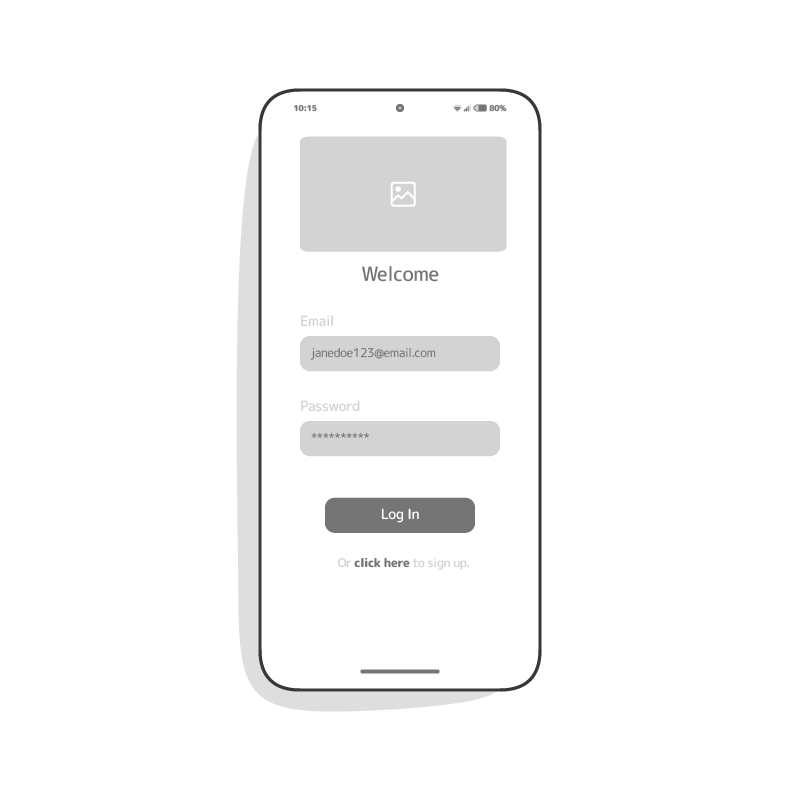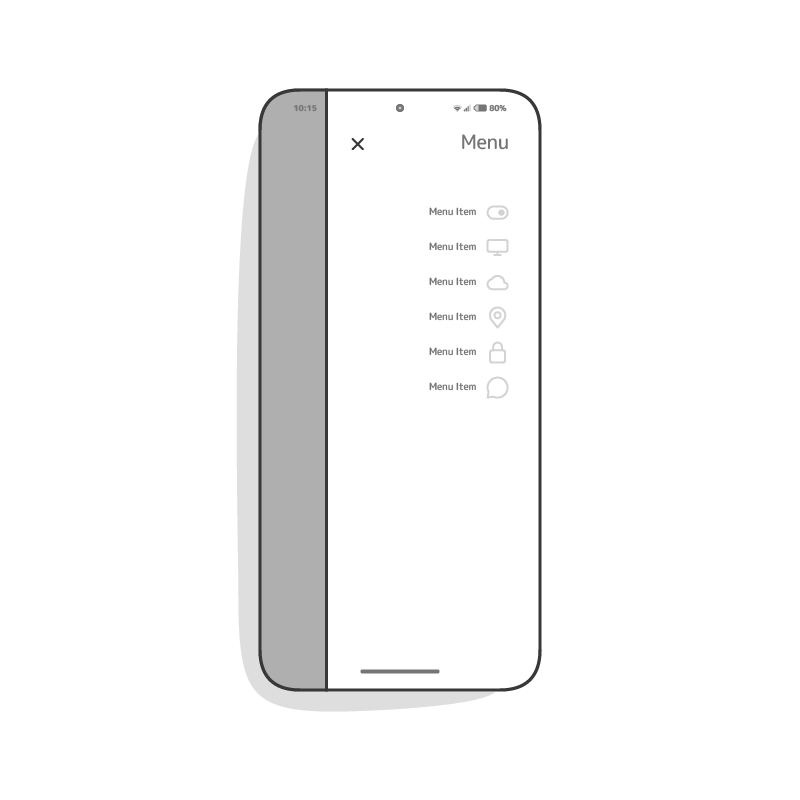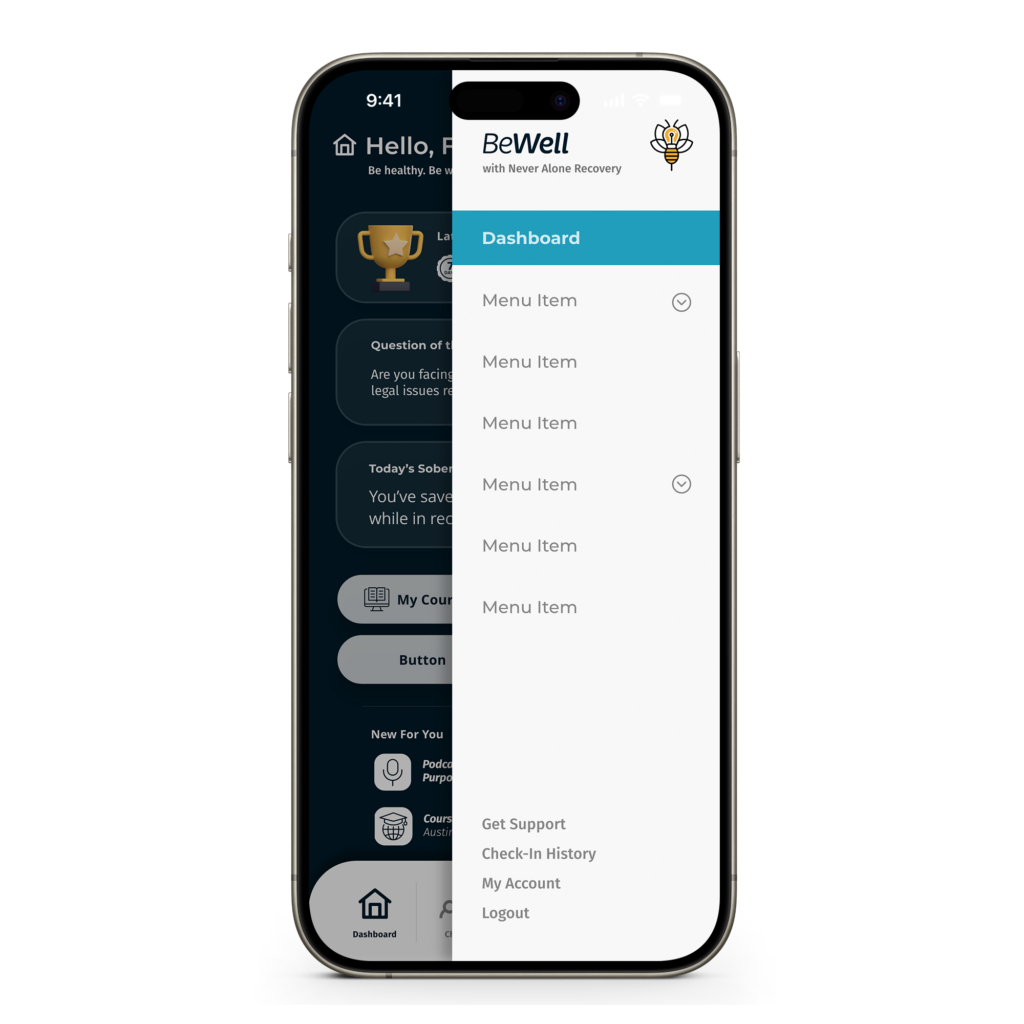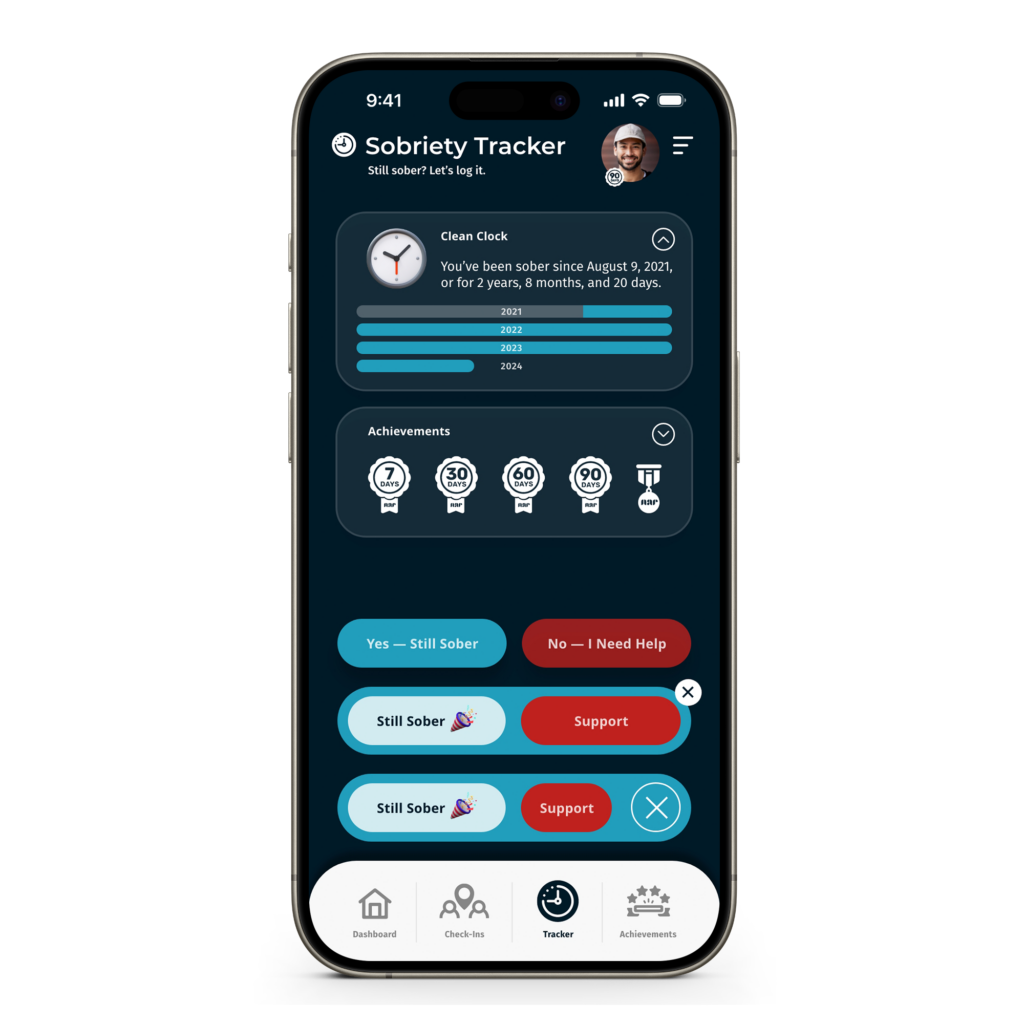Never Alone Recovery Mobile App and Accountability System
Having grown and expanded over the last seven years, Never Alone Recovery had a vision for a mobile app that could elevate their support offerings, expand the organization’s reach, and, as a result, help more people.
I created the visual language for the app and conceptualized key features, including a recovery tracker and gamification elements, to support users in their mental health and recovery journeys.
Check out an early, soft-launch version of the app now:
Multifunctional Support App with Progress Tracking & Location-Based Meeting Finder
Lead Designer
Mental Health
12 Weeks
Challenges
Designing and prototyping interactive elements, building a guided onboarding process, and creating a clean, intuitive interface required a balance between aesthetic appeal and user functionality, ensuring seamless navigation and effective informational hierarchies.
Special attention was given to incorporating motivational and supportive elements to enhance user engagement and experience.
Designing a System for Tracking Achievements
- Defining how new sobriety tracking features will look and function, ensuring they align with user needs and expectations.
- Identifying regular, intuitive touchpoints where users can log their progress and earn points without it feeling burdensome.
- Developing an underlying points/credit system that contextualizes sobriety milestones and helps maintain user motivation.
- Simplifying the process of recording achievements to ensure it doesn’t feel like a chore, ensuring more consistent engagement with the function.
Building the Onboarding Process
- Ensuring the onboarding process captures critical data (e.g., sobriety start date) necessary to unlock core app functionalities.
- Creating an onboarding flow that feels intuitive and minimizes the perception of effort required from users when providing personal information.
- Preventing users from feeling restricted or limited in the app’s functionality during the onboarding process, ensuring that key features are accessible early on.
Defining the Accountability Framework
- Establishing the structure of the accountability system to track and reinforce user progress.
- Exploring ways to introduce gamification features like rewards, progress tracking, and challenges to make healthy decision-making more inherently rewarding.
- Considering how gamification could introduce positive user behaviors and make them more sustainable over time.
Design & Development Process
Audience
The app’s target users would encompass both males and females across a wide age range with one of the only criteria being that they’re already somewhat tech-literate and familiar with digital tools.
Through the app, the intent would be to give those experiencing a wide variety of mental health challenges access to a curated collection of bespoke resources (e.g. downloadable media, free and premium elearning, etc.) and even real-time support.
Accountability Framework with Gamification
To address the challenge of incorporating gamification into our accountability system, I drew inspiration from a range of successful apps that have mastered user engagement through rewards and motivation:
- Duolingo, for instance, uses streaks and badges to encourage users to stay consistent with their language learning. By analyzing this approach, I introduced similar streak rewards and achievement badges into our app, recognizing that celebrating sobriety milestones would provide users with a sense of accomplishment and motivation to maintain their progress. We explored social and community-based features inspired by Duolingo’s leaderboards and group challenges. Although this was a secondary focus, we envisioned these features fostering a sense of community, allowing users to share their achievements, and creating an additional layer of motivation through peer support and group accountability.
- Fitbit’s goal-setting and progress-tracking mechanisms also played a key role in shaping our system. Fitbit allows users to set personalized fitness goals and visually track their progress, which inspired us to create a system where users could set their own sobriety goals. We implemented features like progress bars and daily check-ins to offer a clear, visual representation of their journey, allowing them to see their achievements and stay focused on their goals.
- Waze’s real-time feedback mechanisms influenced the way we incorporated notifications and updates. We wanted to provide users with instant feedback and reminders to reinforce positive behaviors without becoming intrusive. This balance between gentle nudges and real-time updates ensured that users stayed engaged and accountable without feeling overwhelmed by the tracking process.
Onboarding Process for New Users
The ability of the app to track sobriety milestones hinges on the user providing certain details, such as the date they became sober. Without this information, the app’s core features couldn’t be fully activated, which risked creating a restricted experience that could be off-putting to new users.
To minimize friction during onboarding, we broke the process into smaller steps. Instead of overwhelming users with a long form at the outset, we designed the onboarding flow to be conversational, asking for critical information at key moments.
To ensure users didn’t feel restricted, we also explored ways to let them experience key parts of the app even if they chose to skip certain steps during onboarding. For example, users could access general features or receive reminders to complete their profile later, allowing them to familiarize themselves with the app before fully committing. This progressive onboarding approach allowed users to ease into the experience while still capturing the essential information required for personalized functionality.
Tracking Sobriety Achievements
Ensuring that users could regularly engage with the app, accrue points or credit for their achievements, and track their progress without the experience feeling like a chore was a major priority. For this, we drew some inspiration from Noom, which uses psychology-based techniques to drive long-term behavior change through consistent but manageable daily check-ins. Noom’s emphasis on small, actionable steps inspired us to design a system that encouraged users to make daily progress without feeling overwhelmed. This daily engagement would build momentum, helping users stay on track with their sobriety goals.
Additionally, we looked at Strava for its social and community elements. Strava fosters motivation by encouraging users to compete against their own personal bests or with friends. This led us to consider ways in which we could incorporate peer accountability or group challenges into our sobriety-tracking system. By allowing users to share their progress with others, we could foster a supportive community atmosphere, which would motivate users to stay consistent in their sobriety journey.
Once again, we looked to Fitbit for its intuitive goal-setting and tracking features. We hoped to adopt a similar approach by making sobriety tracking simple and user-friendly, allowing users to log progress easily through daily or weekly entries. To ensure this felt seamless rather than cumbersome, we incorporated gentle reminders and quick-entry options, so users could track without feeling obligated to engage in a time-consuming process.
Design
Visual Language
- Neutral colors paired with dark navy evoke professionalism, experience, and reassurance.
- Soothing rounded shapes instead of harsh corners and jagged lines.
- Minimal material design with a splash of glassmorphism to create a modern, sleek look.
Navigational Elements
- Application Dashboard: Featuring a persistent bottom navigation bar for easy access to core functionalities, this bottom dock remains fixed, overlaying all content within the app to ensure constant accessibility for the user.
- Slide-Out Navigation Drawer: A secondary menu accessible through a top-right icon, designed to overlay the main content and bottom dock, highlighting its importance when engaged.
Typography
- By the client’s request, Montserrat was the chosen as the display font for headings as well as most UI elements.
- Selected Fira Sans for body text.
Wireframing
Wireframes and mockups were created to visualize the app’s structure and flow. Interactive prototypes were developed to test and refine the user experience.
Key Features & Functionality
The app is designed as an on-demand source of innovative tools capable of supporting individuals as they transition from addiction or mental health challenges to sustainable health and well-being.
Given that relapse/recidivism is often a result of insufficient support, the app could help individuals to persevere through those difficult times. Or as things turn around, their progress can be incentivized through gamification elements.
These features ensure that users have the resources and motivation they need to achieve and maintain their recovery goals.
More Than Sober
Designed to support users seeking a fresh start, the app features intuitive and accessible tools for tracking and rewarding progress, and providing on-demand support in times of crisis.
Sobriety Tracker
A pivotal feature conceptualized as an accountability tool with personalized overviews of users’ recovery journeys. A card-based dashboard layout provides dynamically-calculated figures like total days sober, money saved, and health improvements.
Users can then share their milestones on social media, turning raw data into motivational achievements.
Gamifying Wellness
Incorporating elements of gamification to encourage not only continued use and engagement with the app but should also decrease risk of relapse.
Rewards and incentives are provided for reaching milestones, fostering a sense of accomplishment and motivation.
Project Timeline
The development of the BeWell app followed a structured timeline to ensure thorough planning, design, and execution. Each phase, from initial research and ideation to post-launch evaluation, was meticulously managed to create a seamless and effective user experience.
This timeline highlights the key stages and milestones that guided the project to its successful completion.
1. Research & Ideation
- Market and audience research
- Defining goals and objectives
2. Planning
- Establishing project scope
- Creating a roadmap
- Resource allocation and scheduling
3. Design
- User personas, wireframing, user flows, and interaction design
- Visual design, branding, and mockups
4. Prototyping
- Developing interactive prototypes
- Testing and refining user experience
5. Development
- Setting up development environment
- Coding front-end and back-end
- Integrating APIs and third-party services
6. Testing
- Unit, integration, and systems testing
- User Acceptance Testing (UAT)
- Bug fixing and optimization
7. Soft Launch (Current)
- Deploying app to production
- App store submission and approval
8. Post-Launch
- Monitoring performance and user feedback
- Regular updates with new features and bug fixes
- Marketing and promotion
- Analyzing user data and performance metrics
- Planning future updates and iterations
More Updates to Come
The app I designed for Never Alone Recovery will provide comprehensive support for individuals on their recovery journeys. Through careful planning, design, and development, the app will provide users with an intuitive, user-friendly experience with features that empowers them to track their progress and stay motivated.
This case study, though still a work-in-progress, breaks down some of my process and dedication involved in creating a tool that aims to make a meaningful impact on mental health and recovery.

